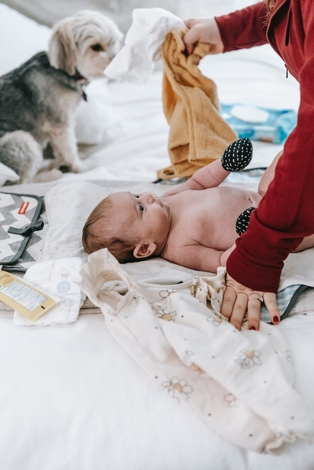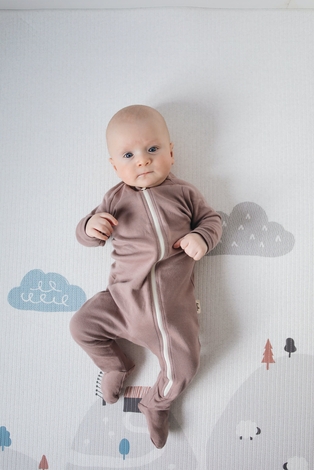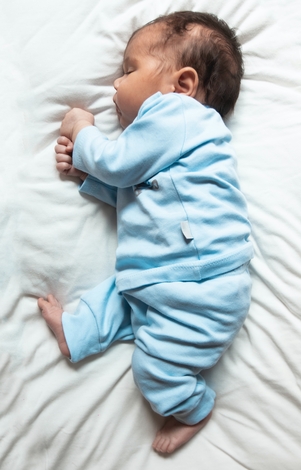Being first-time parents is one of the most nerve-wracking moments in life. Reading books, watching videos, and listening to other “experts” may enlighten you a bit. In truth, nothing can adequately prepare you once the bundle of joy is in your arms. The mixed emotions of joy and excitement, of anxiety and concern fill your mind: is your baby happy, is the baby growing well, is the baby’s brain stimulated, and most of all, is the baby sleeping well?
One of the things to consider is what dresses for newborn babies to wear while sleeping. Dr Nilong Vyas, a pediatrician, suggests this simple and basic rule: Less is More, as stated in a Sleep Foundation article. The article suggests just adding one more layer to the baby’s sleepwear, based on what parents would wear in the same room at that particular temperature. For instance, if mommy wears a T-shirt and pajamas to sleep, baby can wear a long-sleeved onesie that covers their feet. It is best to opt for soft, breathable fabrics like cotton or muslin. These materials allow air circulation, preventing overheating and ensuring your baby stays cozy without feeling too warm. Skin sensitivity may also be an issue for some babies. Choose clothing made from soft, hypoallergenic fabrics to prevent irritation or allergic reactions, allowing them to sleep peacefully without discomfort. Again, cotton and muslin are safe options, but it is best to read the labels of babies’ clothes.
How to Dress Your Baby for Sleep?

Once you have decided on the sleep attire for your baby, follow these steps to safely dress them for sleep:
1. First, lay the clothes out flat, unbuttoned or unzipped.
2. Second, have the baby lie down on a soft yet safe surface like a changing table. You can talk to the baby, calmly explaining what is about to happen. This can help the baby feel relaxed while you dress them, fostering a sense of trust and safety.
3. The third step depends on the attire. If the attire is a shirt that goes over the baby’s head, gently support the baby’s nape with one hand as the other hand puts the shirt through the head and then over the torso. Proceed to put the sleeves by slowly guiding the arms through the sleeves. This process avoids sudden movements that could startle some babies. The same goes for putting on the pajamas by gently lifting the leg and pulling the pants one leg at a time.
4. Finally, fasten buttons, snaps, and zippers. Make sure they are comfortably secure without being too tight or restrictive. Double-check that all closures are aligned and adjusted. Now your baby is ready for dreamland.
How to Swaddle Your Baby for Sleep?

Another popular option is swaddling, closely wrapping your baby with a thin blanket. This is commonly used in newborns to mimic the cozy feeling of being in the womb. Here are the steps to properly swaddle your baby:
1. First, select a lightweight, breathable blanket specifically for swaddling. These are usually made of cotton or muslin. Lay the blanket on a flat surface in the shape of a diamond, with the top corner folded down.
2. Then, lay your baby down on top of the blanket, with their head just above the folded corner. Make sure arms are not stretched out.
3. Now comes the swaddling. Take the left corner of the blanket and bring it across your baby’s chest. Tuck this corner underneath the baby’s body, ensuring the right arm is secure but not tight.
4. Proceed to the bottom corner of the blanket by folding it up over the baby’s feet, and tucking it over the shoulder or side. Make room for your baby to move, so do not pull too tightly.
5. Finally, secure the other side of the blanket and again wrap it across your baby’s chest. Tuck the corner underneath the baby’s left side. Do not forget to allow some space for movement.
Tips:
A properly made swaddle should be snug around a baby’s torso but loose enough for their legs to move freely.
Dr. Vyas cautions parents on swaddling babies because there is actually no evidence stating that swaddling is safer than dressing a baby in layered sleepwear. “In fact, swaddling can be risky once a baby starts rolling over on their own, because it is very difficult for a swaddled baby to turn again if they wind up face-down.” This is why swaddling should not be done when the baby is two months old.
Sleepwear Add-ons
What about blankets and hats? Dressing your baby in appropriate sleepwear reduces the necessity for additional blankets or pillows in the crib. This decreases the risk of suffocation or entrapment during sleep. Unless it is necessary, experts suggest using wearable blankets or sleepsacks. A sleepsack looks like a sleeping bag that covers the torso of your baby snugly while still allowing the hands and arms to move freely. These are considered safe and effective as long as they do not restrict your baby’s movements. As for hats, the American Academy of Pediatrics says that hats are needed only for a few hours after your baby is born. Newborns are gradually learning to regulate their body temperature, so a hat may not be helpful at this point. It may even cause overheating or reduce an infant’s inability to absorb oxygen through the skin.
Why What to Wear to Sleep Matters?

Dressing your baby for sleep is not a complicated matter, but it is important to consider what kinds of clothes help them sleep better. The right clothes matter because they regulate body temperature. Newborns and infants have a limited ability to control their body heat. This is due to the fact that infants have a larger body surface area compared to their body weight, making them more prone to heat loss, according to Hirobumi Asakura’s article in Pubmed, the National Library of Medicine. Infants have immature nervous systems that impair their ability to react to cold temperatures efficiently, making it crucial to maintain a comfortable temperature through appropriate dressing.
On the other hand, there is the risk of overheating in babies. Overheating has been linked to an increased risk of Sudden Infant Death Syndrome or SIDS. “Overbundling, or dressing your baby in too many layers of clothing and bedding for the temperature of the room, can increase the risk of SIDS”, according to the US National Institute of Health’s Safe to Sleep Program. The very young brains of infants are still learning to process and function properly. Sometimes, there are malfunctions in their nerve cells in charge of regulating heart rate, breathing, temperature, and blood pressure. Researchers believe that this is a cause of SIDS. Do not overthink your baby’s sleepwear. Keep in mind: less is more.
Is Your Baby in Dreamland?
Now that the baby is fast asleep, how can parents tell if their baby is really comfortable? To see if your baby is feeling hot while sleeping, gently touch or feel the neck and stomach. Check the neck and hair if it is warm to the touch or if there is sweat. Feel the tummy if it is not too warm when touched. Lastly, take a look at your baby’s ears and touch the cheeks. If the skin is red and again warm to the touch, this is an indication that your baby is feeling warm while asleep. Gradually remove one layer of clothing at a time, so as not to disrupt their sleep.
On the other hand, to see if your baby is feeling cold, it is best to feel the chest, neck, tummy, and back. If the baby is cool to the touch, then your baby must be feeling chilly. It is interesting to note that your baby’s fingers and toes are, in fact, not good indicators of warmth. Should this happen, Parents should simply add one layer of clothing to a baby that is feeling cold. As mentioned before, blankets are a possible suffocation hazard in cribs, so avoid using blankets as a layer of warmth for your baby.
Conclusion
The best takeaway from this article is to not stress or obsess. Dressing your baby for sleep is a matter of trial and error, of adding and subtracting. By following proper dressing guidelines and considering the evidence-backed insights provided, you can create a safe and conducive sleep environment for your precious little ones, paving the way for a night filled with beautiful dreams and a morning greeted by a smiling, well-rested baby.

